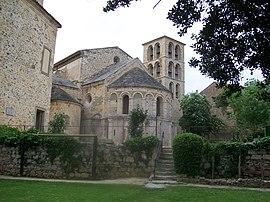
Back Caunes-Minervois AST Caunas de Menerbés Catalan Кон-МинегӀвуа CE Caunes-Minervois CEB Caunes-Minervois German Caunes-Minervois DIQ Κων-Μινερβουά Greek Caunes-Minervois Spanish Caunas de Menerbés Basque Caunes-Minervois Finnish
Caunes-Minervois | |
|---|---|
 Abbey | |
| Coordinates: 43°19′39″N 2°31′44″E / 43.3275°N 2.5289°E | |
| Country | France |
| Region | Occitania |
| Department | Aude |
| Arrondissement | Carcassonne |
| Canton | Le Haut-Minervois |
| Intercommunality | Carcassonne Agglo |
| Government | |
| • Mayor (2023–2026) | Ludovic Barlaud[1] |
Area 1 | 27.84 km2 (10.75 sq mi) |
| Population (2022)[2] | 1,571 |
| • Density | 56/km2 (150/sq mi) |
| Time zone | UTC+01:00 (CET) |
| • Summer (DST) | UTC+02:00 (CEST) |
| INSEE/Postal code | 11081 /11160 |
| Elevation | 144–861 m (472–2,825 ft) (avg. 176 m or 577 ft) |
| 1 French Land Register data, which excludes lakes, ponds, glaciers > 1 km2 (0.386 sq mi or 247 acres) and river estuaries. | |
Caunes-Minervois is a small medieval town and commune in the Aude department in the Occitanie region in southern France. It is known particularly for its ancient Abbey, dating from the eighth century, and the outstanding red marble that has been quarried locally from Roman times. The name may derive from the ancient local Occitan word for cave, "cauna", of which there are a number in the immediate area.
Caunes is also in the Minervois, a designated wine growing region with AOC status but with an ancient heritage. The name derives from the ancient regional capital of Minerve, some 20 km east of Caunes, itself named for the Roman Goddess Minerva. The Romans came through here, settling and introducing vines & olives in the region. Minervois Vignerons have been dynamic in changing the perception of the world towards wine from the south of France, developing quality products and experimenting with both old and new grape varieties and techniques.[3]
The ruined castle (chateau) at Minerve is a site attracting many visitors due to the ongoing interest in Catharism and the Albigensian Crusade. Caunes lies in the northern part of the modern touristic region of the "Pays Cathare" – Cathar Country – which stretches here from the Pyrenees.
- ^ "Répertoire national des élus: les maires" (in French). data.gouv.fr, Plateforme ouverte des données publiques françaises. 6 June 2023.
- ^ "Populations de référence 2022" (in French). The National Institute of Statistics and Economic Studies. 19 December 2024.
- ^ Strang, P. 2002. Languedoc-Roussillon: The Wines and Wine Makers. Mitchell Beazley, 2002. ISBN 1-84000-500-9



